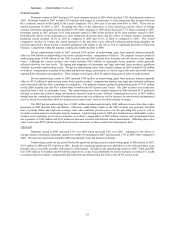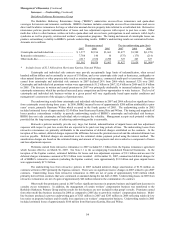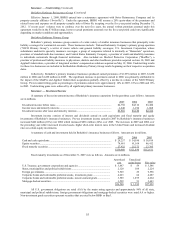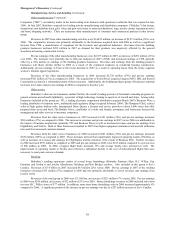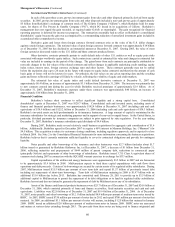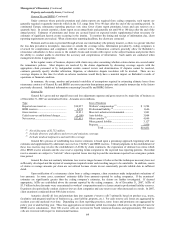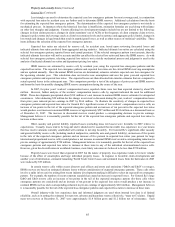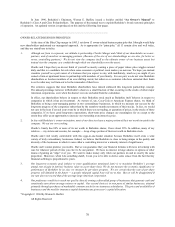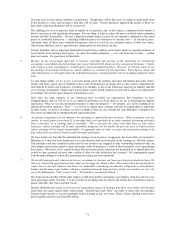Berkshire Hathaway 2007 Annual Report Download - page 63
Download and view the complete annual report
Please find page 63 of the 2007 Berkshire Hathaway annual report below. You can navigate through the pages in the report by either clicking on the pages listed below, or by using the keyword search tool below to find specific information within the annual report.
62
Management’s Discussion (Continued)
Property and casualty losses (Continued)
Berkshire records liabilities for unpaid losses and loss adjustment expenses under property and casualty insurance and
reinsurance contracts based upon estimates of the ultimate amounts payable under the contracts with respect to losses occurring
on or before the balance sheet date. Depending on the type of loss, the timing and amount of loss payments are subject to a great
degree of variability and are contingent upon, among other things, the timing of claim reporting from insureds and cedants and
the determination and payment of the ultimate loss amount through the loss adjustment process. A variety of techniques are used
to establish and review the liabilities for unpaid losses recorded as of the balance sheet date. While techniques may vary,
significant judgments and assumptions are necessary in projecting the ultimate amount payable in the future with respect to loss
events that have occurred. As a result, uncertainties are imbedded in and permeate the actuarial loss reserving techniques and
processes for all of Berkshire’ s property and casualty insurance and reinsurance businesses.
As of any balance sheet date, claims that have occurred have not all been reported and if reported may not have been
settled. Loss and loss adjustment expense reserves include provisions for reported claims (referred to as “case reserves”) and for
claims that have not been reported, referred to as incurred but not yet reported (“IBNR”) reserves. The time period between the
occurrence date and payment date of a loss is referred to as the “claim-tail.” Property claims usually have fairly short claim-tails
and, absent litigation, are reported and settled within no more than a few years after occurrence. Casualty losses usually have
very long claim-tails, occasionally extending for decades. Casualty claims are more susceptible to litigation and can be
significantly affected by changing contract interpretations and the legal environment which further contributes to the extended
claim-tails.
Receivables recorded with respect to insurance losses ceded to other reinsurers under reinsurance contracts are
estimated in a manner similar to liabilities for insurance losses and, therefore, are also subject to estimation error. In addition to
the factors cited above, reinsurance recoverables may ultimately prove to be uncollectible if the reinsurer is unable to perform
under the contract. Reinsurance contracts do not relieve the ceding company of its obligations to indemnify its own
policyholders.
Each of Berkshire’ s insurance businesses utilizes loss reserving techniques that are believed to best fit its business.
Additional information regarding reserves established by each of the significant businesses (GEICO, General Re and BHRG)
follows.
GEICO
GEICO’ s gross unpaid losses and loss adjustment expense reserves as of December 31, 2007 were $6,642 million. As
of December 31, 2007, gross reserves included $4,735 million of reported average, case and case development reserves and
$1,907 million of IBNR reserves.
GEICO predominantly writes private passenger auto insurance which has a relatively short claim-tail. The key
assumptions affecting GEICO’ s reserves include projections of ultimate claim counts (“frequency”) and average loss per claim
(“severity”), which includes loss adjustment expenses.
GEICO’ s reserving methodologies produce reserve estimates based upon the individual claims (or a “ground-up”
approach), which in the aggregate yields a point estimate of the ultimate losses and loss adjustment expenses. Ranges of loss
estimates are not determined in the aggregate. A detailed discussion of the process and significant factors considered in
establishing reserves follows.
Actuaries establish and evaluate unpaid loss reserves using recognized standard actuarial loss development methods
and techniques. The significant reserve components (and percentage of gross reserves) are: (1) average reserves (20%), (2) case
and case development reserves (50%) and (3) IBNR reserves (30%). Each component of loss reserves is affected by the
expected frequencies and average severities of claims. Such amounts are analyzed using actuarial techniques on historical claims
data and adjusted when appropriate to reflect perceived changes in loss patterns. Data is analyzed by policy coverage, rated
state, reporting date and occurrence date, among other factors. A brief discussion of each component follows.
Average reserve amounts are established for reported auto damage claims and new liability claims prior to the
development of an individual case reserve. The average reserves are established as a reasonable estimate for incurred claims for
which claims adjusters have insufficient time and information to make specific claim estimates and for a large number of minor
physical damage claims that are paid within a relatively short time after being reported. Average reserve amounts are driven by
the estimated average severity per claim and the number of new claims opened. The average severity per claim amount is
developed by projecting the ultimate severities for each accident quarter and weighting with both reported claims and estimated
unreported claims.
Claims adjusters generally establish individual liability claim case loss and loss adjustment expense reserve estimates
as soon as the specific facts and merits of each claim can be evaluated. Case reserves represent the amounts that in the judgment
of the adjusters are reasonably expected to be paid in the future to completely settle the claim, including expenses. Individual
case reserves are subsequently revised as more information becomes known.
For most liability coverages, case reserves alone are an insufficient measure of the ultimate cost due in part to the
longer claim-tail, the greater chance of protracted litigation and the incompleteness of facts available at the time the case reserve
is established. Therefore, additional case development reserve estimates are established, usually as a percentage of the case
reserve. As of December 31, 2007, case development reserves averaged approximately 20% of total established case reserves.
In general, case development factors are selected by a retrospective analysis of the overall adequacy of historical case reserves.
Case development factors are reviewed and revised periodically.



